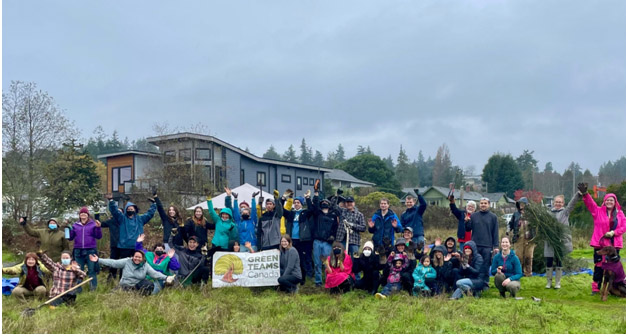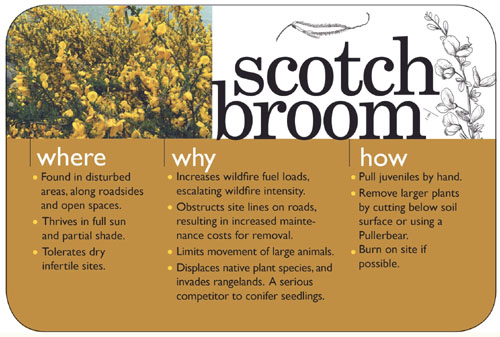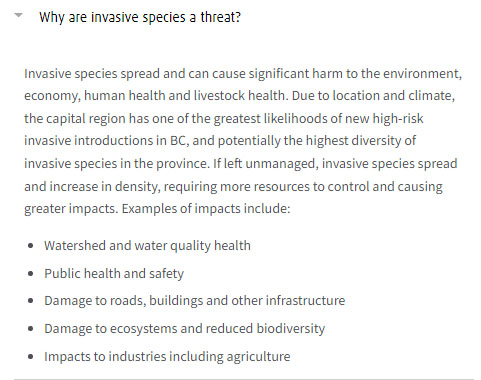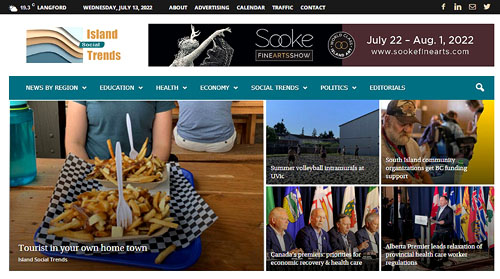
Friday July 15, 2022 | VICTORIA, BC
by Molly Pearce, with notes by Mary P Brooke | Island Social Trends
The Greater Victoria area is a hotbed for invasive plant life. These non-native plants are not only annoyingly persistent features of our gardens, however, but can be ecologically destructive in their dominance over local biodiversity.
The Capital Regional District (CRD) explains, “Due to location and climate, the capital region has one of the greatest likelihoods of new high-risk invasive introductions in BC, and potentially the highest diversity of invasive species in the province.”
People do enjoy the bright yellow colour of Scotch Broom and the tasty berries of Himalayan Blackberry. But it’s important to help maintain natural species on the island, to keep things in balance.
Highest priority species:
The highest priority invasive species, according to the CRD, include Black Knapweed, Blessed Milk Thistle, Death Cap Mushroom, Giant Hogweed, Gorse, Knotweed, Poison Hemlock, Policeman’s Helmet, Shiny Geranium, and Yellow Flag Iris.
The CRD has more info on each invasive species, available for download.
These species produce concern for several reasons. While each invasive plant species may pose its own unique hassle in our backyards, the larger effect of these plants on the native ecology of the lower island is detrimental.
The damage done by non-native species to both the flora and fauna of our native ecosystem is significant. Natural constraints such as predators or climate limitations may not affect incoming invasive species, which allows them to rapidly dominate over native plants. When the spread of invasive species is left unchecked, we often see a decline in the plants and animals which rely on would have relied on the displaced native plants for survival.
Municipal approaches:
Municipalities in the Greater Victoria area for the most part have common approaches to the removal of invasive plant species. Most municipalities rely on the manual and mechanical removal of invasive species by their teams and by local volunteer groups.
There is little information circulated from the municipalities about the use of chemicals to remove unwanted plant species. Saanich is an exception, however, as they report that in exceptional circumstances when mechanical removal is not possible, they will treat particular culprit invasive species with herbicides.
- Saanich has its own volunteer invasive species removal team. The “Pulling Together” ecological restoration program has been in place since 1999 and has continued thanks to the hard works of its community members.
- Colwood has a gardener-friendly approach to controlling the intruders, with a phone line available for the public to call if they are unsure about what’s what in their back yards. The municipality also has a branch drop off location to facilitate the public’s removal of invasive plant species on their own property.
- Metchosin: the Metchosin Invasive Species Cooperative is in its fourth year of a five-year grant it is receiving from The Habitat Conservation Trust Foundation. From 2021-2022, the Cooperative completed a total of 10 holly pulls, and pulled approximately 10 639 plants.
Alongside these municipalities, Langford, View Royal, and Sooke are participants in the Capital Regional Invasive Species Partnership-Intergovernmental Working Group—or CRISP-IWG for short. The group is a collaboration between local governments, First Nations, and other stakeholders to detect, track, and stop the spread of invasive species to address their risk to the environment.
How to help out:
If you’re looking to get out there and get your hands dirty to help defend our local ecosystems, local organizations such as the Victoria Green Team, Pulling Together, and the Metchosin Invasive Species Cooperative all welcome volunteers to help with their group invasive species pulls. These groups often organize their removal events in parks around the CRD.

Several organized volunteer events on the southern Vancouver Island also engage the community in efforts to remove invasive species from parks. The University of Victoria Society for Ecological Restoration’s “Make a Difference Week” ran this year from June 4 through June 11. The Metchosin Invasive Species Cooperative participated this year for the second year in a row at Matheson Lake Park.
Control vs eradication:
Where invasive plant species cannot be completely eradicated, they can at least be controlled. The survival of many endangered native plants on southern Vancouver Island is dependent on the hard work of individual volunteers who put their green thumbs to use for a good cause.
In terms of your own land or garden, it helps if you can keep invasive species to a minimum.
Safe disposal:
Carefully dispose of invasive plants in the appropriate way at the appropriate location. This is critical to help reduce the further spread of invasive species as many invasive species outbreaks start by inappropriate or illegal dumping.
Note: Some invasive species such as giant hogweed, poison hemlock and daphne laurel can be harmful if touched; please ensure you are wearing protective clothing if handling these species.
===== RELATED:
Native species planted into riparian zone around new handyDART facility (May 19, 2022)
Dogwood tree planted in Colwood park on Earth Day (April 24, 2022)
Rain didn’t stop Colwood’s latest invasive species cleanup (November 28, 2021)
Councillors pitch in with brush clearing at Perimeter Park in Colwood (March 8, 2020)








